Introduction: In this article, Melissa Davenport Berry writes about the famous Nabisco cracker/cookie company, starting with John Pearson’s mill in 1643. Melissa is a genealogist who has a blog, AnceStory Archives, and a Facebook group, New England Family Genealogy and History.
Here is a little tidbit to nibble on: the first commercial bakery in America was birthed in Newburyport, Massachusetts, and is known today as Nabisco. The start of a food empire began in 1792 when the Pearson clan produced a specialty cracker known as Pilot Bread, or ship’s biscuit, a refined version of hardtack. I was able to trace the history of this enterprise by searching through GenealogyBank’s Historical Newspaper Archives.
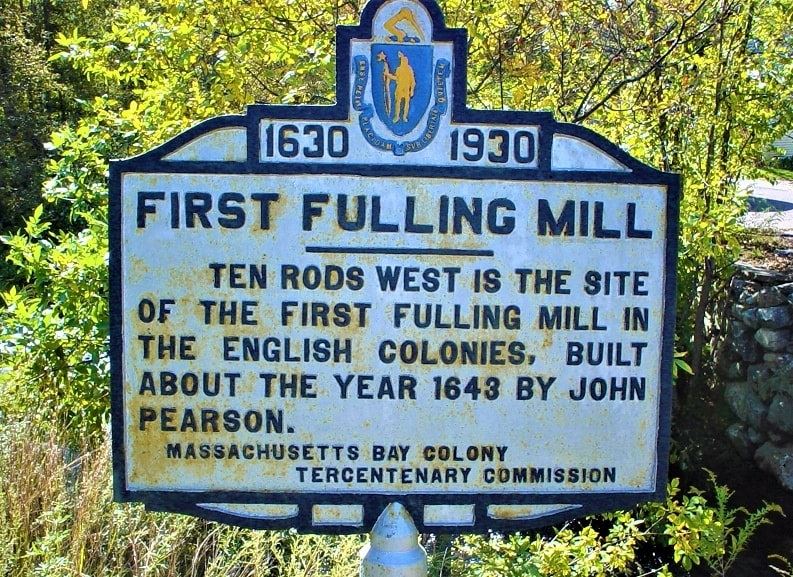
The Pearson name was well established way before their hot buns hit the market. According to newspaper articles and other sources, including John J. Currier’s History of Newburyport, MA 1764-1905, John Pearson, the lineal forerunner, was responsible for erecting the first fulling mill in the North American Colonies, on Mill River. He used a cedar tenter post, brought from England.
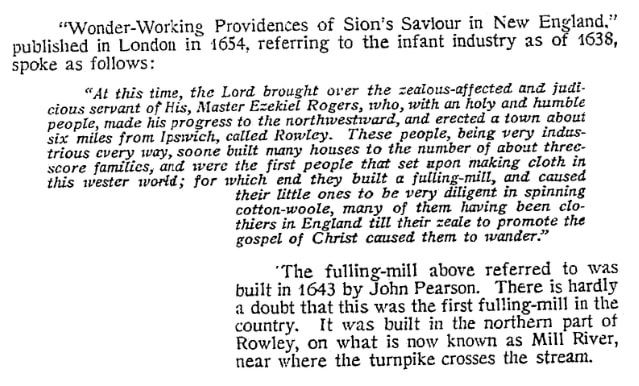
The mill was for the manufacturing of cloth; however, prosperity allowed for expansion and the Pearsons began operating several grist mills. One of the earliest ones was the Short-Pearson family mill.
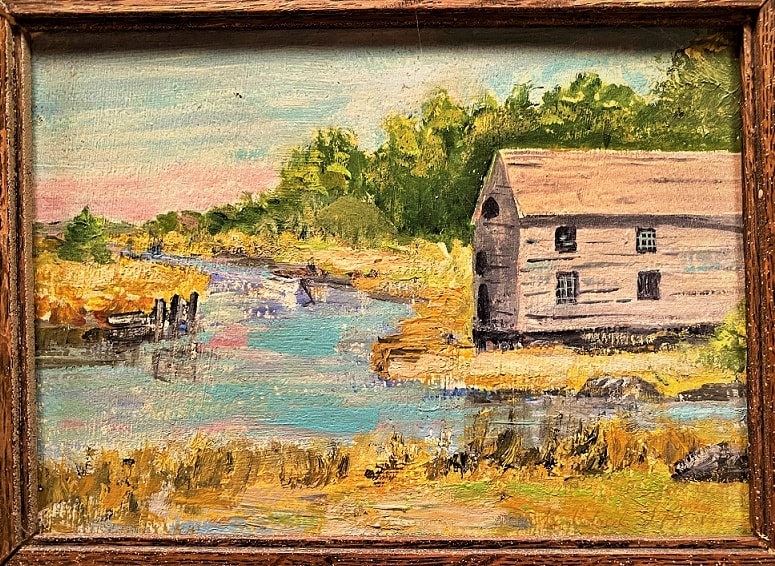
In 1831 Silas Pearson Jr, a miller, provided a clear history of this mill in the Newburyport Herald when he petitioned to build a new mill 100 rods down the river – which the governor approved on 15 May 1831. Some of the grist mills later provided the necessary ingredients and resources to operate Pearson & Sons bakeries.
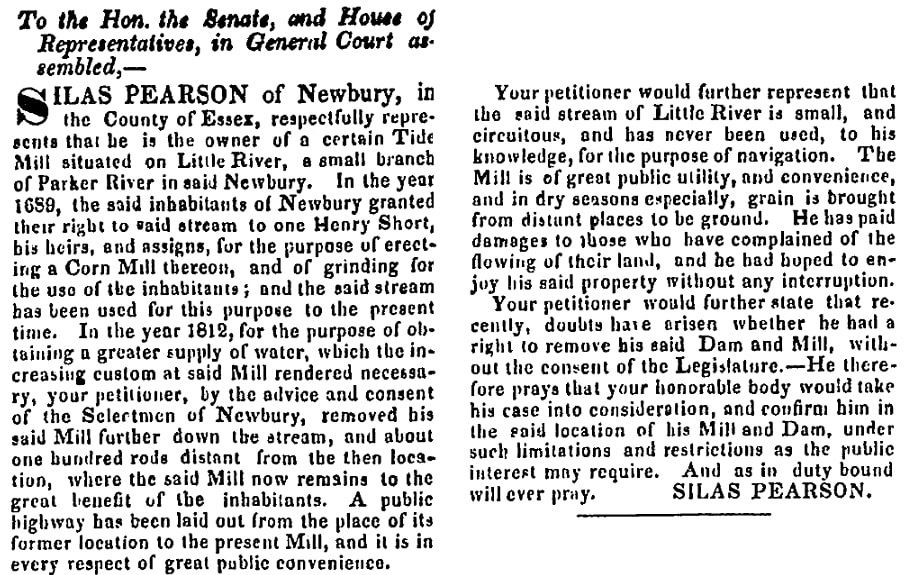
The Pearson bakery had a simple recipe for success, and their product was the major staple for sailing vessels. There was no secret formula, just flour and water; it was the perfect sustenance on lengthy voyages and military campaigns all over the world for years. The shelf life was long and the cost was cheap. The biscuits were 8-9 ounces each and packed into sacks weighing 55-60 pounds.
Portland Grocers ran an ad in the Portland Daily Press in 1867 announcing they carried Pearson’s Cream Biscuit, “Which is receiving the sanction of physicians and the praises of all connoisseurs in such matters.” Testimonials from various news reports included:
“A most delicious article – light, rich and extremely delicate. The high reputation of the old ‘Pearson Bakery’ of Newburyport will be still further enhanced by this welcome contribution to the table.”

By 1869, the Pearson & Sons bakery was well established, and the Portsmouth Journal of Literature and Politics asserted “this bakery was probably the most perfect in the state.” John Jr. was the foreman, supplying the whole country as well as the West Indies. A fire that year left the plant in ashes, but he was not about to crumble after his factory went up in flames, and opened another one.
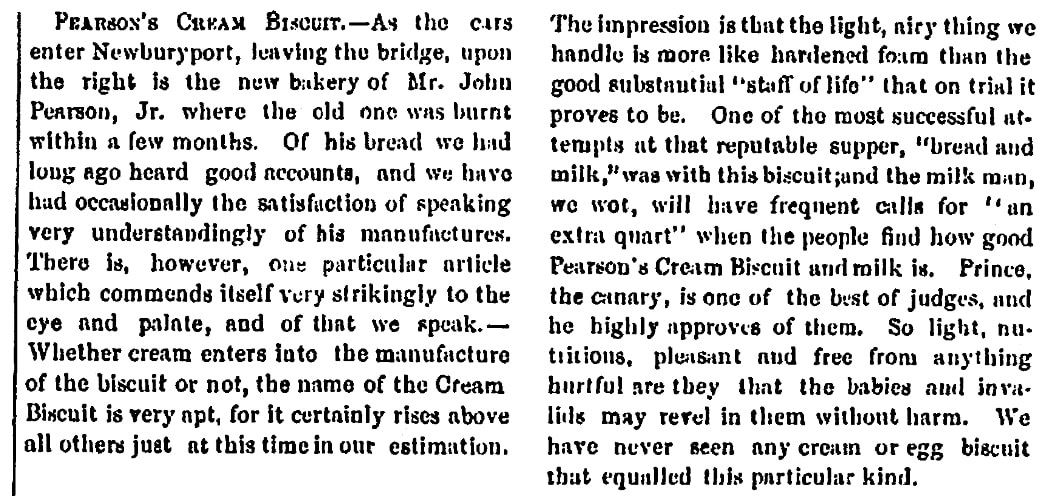
In December of the same year, Pearson was praised again for his tasty Fruit Biscuit with currants, the soda cracker was raised to a new level and promised good eating without accessories with it. A New Year novelty followed with an Amber Biscuit, a spicy gingerbread cake, and finally the Ralston Health Biscuit.
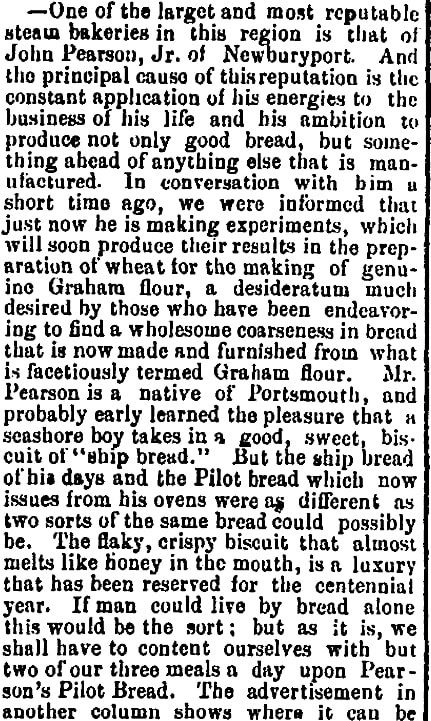
In 1879 the famous Graham Cracker emerged, and John Jr. told the press “something ahead of anything else is being manufactured.” It will make a “flaky, crispy biscuit that almost melts like honey in the mouth.” The word of this report: “If a man could live by bread alone this could be the one.”
In 1890 the John Pearson & Son plant was transferred to the cracker cartel, the New York Biscuit Company, which became known as Nabisco (abbreviated from the earlier name National Biscuit Company). That story will come later.

In 1996, Nabisco tried to capsize the beloved sea biscuit, but Americans were just not ready to jump ship.
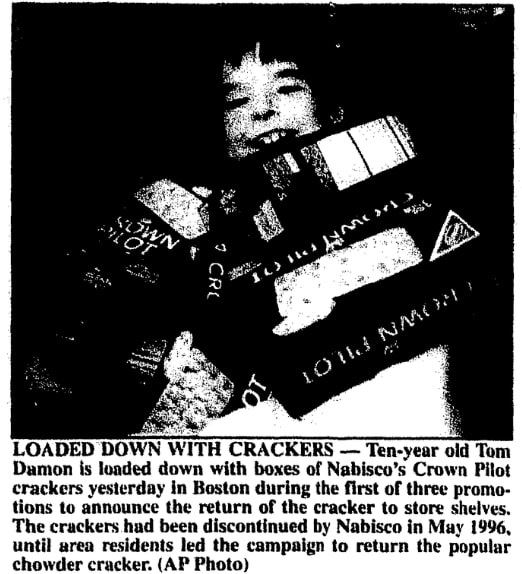
After several thousand calls and complaints on this “culinary blasphemy” accusing the company of desecrating an historical icon, Nabisco revived the Crown Pilot cracker.
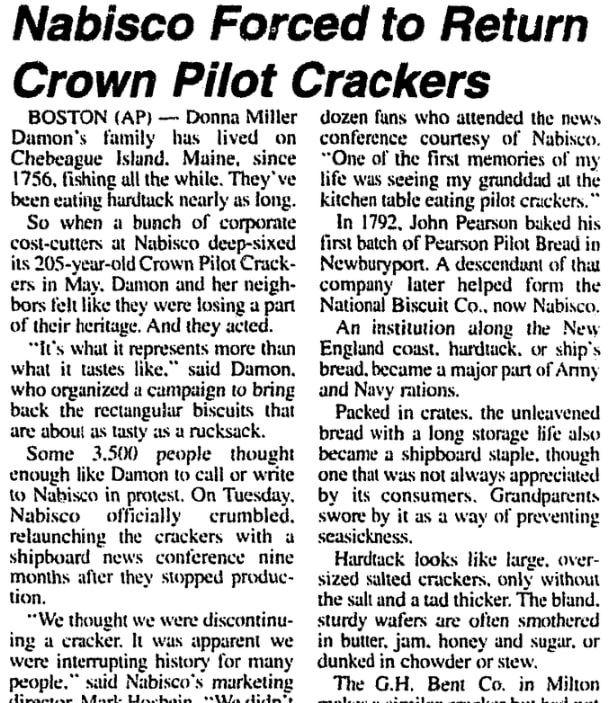
The Brunswick News covered the story on the cooperate cutters and the old Yankee families spoke out. The Damons of Chebeague Island, Maine resident fishermen since 1756, lived on Pearson’s hardtack – and Donna Miller Damon claimed: “It’s what it represents more than what it tastes like.”
Edward Doughty said: “My grandfather who was on the ocean for 70 years loved them. One of the first memories of my life was seeing my granddad at the kitchen table eating pilot crackers.”
Nancy Ryder Petrus of Cape Cod, daughter of a fisherman who grew up on Crown Pilot crackers, noted: “We grew up on these. They’re very important to us. Chowder’s just not the same without them.”
A lesson to Nabisco: Be more a Pearson, who never bit the hand that fed them – it’s the way to make lots of dough.
In the Custom House Maritime Museum in Newburyport there are two of the original boxes used by Pearson. Stop by and find out the sweet course that made them bread winners and not loafers!
Note: An online collection of newspapers, such as GenealogyBank’s Historical Newspaper Archives, is not only a great way to learn about the lives of your ancestors – the old newspaper articles also help you understand American history and the times your ancestors lived in, and the news they talked about and read in their local papers.
Further Reading:
- Currier, John J. History of Newburyport, MA 1764-1905. Newburyport, Massachusetts, 1906.
- Clipper Heritage Trail: Pearson Bakery
- Nabisco National Biscuit Company Wooden Wood Box Crate with History from Pearson to Nabisco at Worth Point
- Harvard University has the Pearson family business records, 1684-1799, v.1 on line: Two account books, dated 1684-1799, kept by members of the Pearson family of Newbury and Rowley, Massachusetts, who operated fulling, grist, and saw mills on the Mill River. Volume one, dated 1681-1711, is a ledger of fulling mill entries of John Pearson, Sr. (1616?-1693), and his sons, John (1644-1723), Jeremiah (1653-1737), and Stephen (1663-1706) showing yards of cloth fulled and payment in cash and in kind. Customers in Newbury, Salisbury, Amesbury, and nearby towns also offered labor, such as spinning, as payment. There is an index to names in the front of the volume, including Peter Cheney, who later built his own fulling mill, and other Newbury residents like Tristram Coffin, Aquila Chase III (1652-1720), Captain Richard Dummer Jr. (1650-1689), John Hale, Thomas Hale Sr., Thomas Hale Jr., and Nathan Parker, possibly the stepson of Mary Parker, who was hanged during the Salem witch trials. Additional accounts include one of Newbury’s founders, Reverend Nicholas Noyes (1615/16-1701), and his sons, Timothy Noyes (1655-1718), Thomas Noyes (1663-1695), John Noyes (1645-1691), and Cutting Noyes (1649-1734). The second volume is an account book, dated 1714-1799, kept by Jeremiah Pearson’s son John (1685-1781) and John’s son Silas (1724-1804). John was a carpenter and cabinetmaker in Stonington, Connecticut, before he returned to Massachusetts to manage the family mill complex. Entries from 1714 to 1724 show debits for carpentry work that John completed, sometimes with the assistance of hired men or his apprentice, Zebediah Mix, as well as money he lent to others. Also included are accounts of John’s payment for personal items such as shoes, 60 acres of land, and legal counsel during a lawsuit. John Pearson moved back to Newbury before 1739, and entries after that date pertain chiefly to the Pearson saw and gristmills. There are additionally accounts of his other sons, including Jeremiah (1718-1797), who purchased boards for his shop, John (1725-1814), for his labor at a prison and at home, and Thomas (1723-1819), for an ax and caulking irons. Silas Pearson’s mill accounts date from about 1750 to 1799. Entries also show charges to the town of Newbury related to assistance for the poor, and notes on meetings of a town committee for the selection of a new pastor, and of the Newbury overseers. Later entries may be of his son Silas (1757-1848), who also was a miller.
Biographical Notes:
- The Pearson family, of Newbury and Rowley, Massachusetts, operated fulling, grist, and sawmills on the Mill River from 1643 into the 19th century. John Pearson (1616?-1693) built the first known fulling mill in the English colonies, and he expanded the business to include additional fulling mills, and grist and saw mills, employing his sons, John (1644-1723), Jeremiah (1653-1737), and Stephen (1663-1706), to assist in running them. The mills were later operated by Jeremiah’s son John (1685-1781), who was succeeded by his son Silas (1724-1804). Silas Pearson Jr. (1757-1848) may have been the last family member to oversee the mills.

My daughter just found this article. I am the 4-5x (?) great grandson of John Pearson. My father shared some of this history with me, but some of it I didn’t know before reading your article. Thank you for researching and sharing.
Thank you John. I loved this story and my Davenport line married into Pearson family in Newburyport. Have you tried the Custom House Museum there? They have some old relics and I believe a file on the family and the bakery.
Of course I love this article. I feel it is very nicely done, Melissa Berry!
I learn relationships & facts from it. Just wish to offer the research that 1792’s cracker batch was baked by John’s father Theodore (1753-1817). John was four years old then. It’s shown in references such as in the year 1895, One Hundred Years of American Commerce, Vol. II, “The Biscuit Industry,” (article by Frank A. Kennedy of New York Biscuit Company). There’s no clear idea who Joseph Pearson is — the one referenced as the first cracker baker, at the Clipper Trail website. Theodore Pearson the baker’s last will is available. There’s further clarity in the genealogy
of The Pearsons and Their Mills.
We’re descended from Silas Sr., then bakers Theodore Pearson, John Pearson, and Theodore Carlton Pearson, who is my 2nd great grandfather; and he is brother to Harris and John Jr. who were also bakers. These are offered not as corrections so much as in alliance of your spirited and informative article.
I heard of these items just barely until the rush of my life slowed down a little and I joined my parents in some genealogy interests.
Best wishes to all Cousins – and everyone is!
Hi Mike. Thank you for sharing all your info.
Captain John Pearson Sr. & Jr. advertised in the Impartial Herald, Newburyport, from 1785-1799. They had a merchant store selling flower and dry goods. One of them was married to an Abigail and the other a Hannah. I found their obituary. They owned ships and are listed in the registers. I believe they were part of the baking business.
Also Jeremiah Pearson is advertising dry goods for sale in Captain Hudson’s store in 1776 and listed as an inn holder in 1790.
Ebenezer Pearson was an inn holder in Amesbury, MA, in 1790. There are many more in town: Amos Pearson, Simeon Pearson, Noyes Pearson, James Pearson, just to name a few. There are loads of ads, etc., if you do a GenealogyBank search in the newspaper archives. Try to do searches; it will give you more information that may not be in the old genealogy/history books.
My Davenport line in Newburyport married into this family. I will look further into this. The Pearson’s ran grain mills early on as well.
Thanks Melissa,
All our efforts together can reward us all. You gave a good start and good continuance.
There’s a book by Russell Leigh Jackson, a descendant of the Leigh family – which included a minister to King George II. It’s called “The Pearsons and Their Mills.”
The King’s minister’s grandnephew inherited the responsibility for operating some of the Pearson mills after the War of 1812 by marrying the daughter of Silas Pearson, Jr., a main heir of Pearson’s mills and land.
The book is about John Pearson and Dorcas Pickard and their descendants.
Well into the list of descendants, it begins the story of a baking line with John, stating that he was born in Newburyport in 1788. We know he’s the son of Theodore Pearson the baker (1753-1817). Theodore’s military service is the only employment information given, though a sea of other information is given about him, including Newbury and Newburyport residency. Other sources confirm him as the baker. John Pearson began baking there as an apprentice at age 11.
The book says his sons John, Harris, and Theodore joined him in baking before his death in 1878. Of those three sons, Theodore is my ancestor. He was also a baker for sure at the family bakery in Newburyport. We have a photo of him and two photos of his second wife, my ancestor, Rhoda Ann Whittier.
In a report of the fire of 1811 in Newburyport, an old-looking article mentions Theodore Pearson’s bakehouse in the lists of things lost. Later on, I couldn’t find the same report but an altered one. Things like this are happening to history in New England. Some of the records online may gradually change even if they look authentically old.
There was a publishing house called Essex Books. They did a report about John Pearson of Rowley, Mass., who is featured on the photo of the sign in your article.
Then there’s the source I mentioned above, cited better here:
“The first cracker bakery in the United States of which we have any trustworthy record was that of Theodore Pearson at Newburyport, Mass., in 1792. His specialty was the pilot or ship bread…” quoted from p. 446 of: “1795-1895, One Hundred Years of American Commerce,” by Chauncey M. Depew, 1925.
Theodore’s brother, Amos, was wounded at Bunker Hill and was a lieutenant in command at the battle of Saratoga.
Amos Pearson, soldier, Part I:
“Amos Pearson, a Bunker Hill soldier, afterwards at the surrender of Burgoyne, gives a vivid sketch of what many endured He was in a company drafted in August 1777. He left on the 23d and marched twenty successive days without halting except at night, sleeping sometimes in the woods, in barns, in log houses, ‘till at sunset they were within ten miles of Gen. Gates’s army. He, a lieutenant in command, had orders to join the army before he slept and did so near Saratoga, N.Y., at three o’clock AM. Soon after he was sent out on a scouting party and brought in thirty prisoners.”
I wish for this to be a net plus for you.
Thanks Mike. I just was sent a book of old original documents from Newburyport dating back to 1740-1820 and there are some with Pearson family. I am going to transcribe them. Stay tuned!
In one episode, during the War of 1812, a mill burned and Silas Jr. was led to believe his two sons, 9 and 17 years old, had done it.
Maybe British agents did it. Silas was by then 56 years old. With his sons banned, his daughter Sarah Jackson Pearson married the grand niece of a minister of King George the Second. The Pearson Mansion became the Leigh mansion. The Leigh husband became the manager of Silas Jr.’s fortune and mills which were considerable.
I have no doubt the young people married for love and peace to all their descendants on account of this.
However, guile and cunning may have occurred in the background. There was a history behind it: two generations earlier, Silas Sr.’s father-in-law Stephen Little was a famous Tory and medical doctor. After being banned in the colonies (along with the governor of New Hampshire), Dr. Little became physician on the HMS George. There, he surely could have told his tales of the Pearson family, known American patriots from the pre-Revolution days. The British might have set their sights on marrying into the branch of the family that inherited most mills, and contrived to blacken the names of Silas Jr.’s sons who were alternative heirs to the fortune.
That story is from “The Pearsons and Their Mills” by Russell Leigh Jackson.
So if you decide to post this comment, it’s just a story drawn from that book.
I mean to say for sure, You’re welcome, Melissa Berry!
I agree with Mike Pearson, having done a lot of research into Theodore Pearson, whose house we live in at 4 Dove Street in Newburyport. John Pearson was incorrectly listed in a few newspaper sources at the originator of the hardtack biscuit — and then others repeated the error — but Mike is right that John was just the very young son who then grew up and inherited the business when it was an increasingly successful one, thus the fame attached to him. But Theodore was the mastermind. His 1788 house, close to what used to be Pearson’s Wharf, has a Newburyport Preservation Trust plaque on it that identifies Theodore as “Baker,” and if you come by during the “If This House Could Talk” event, you can read the house history posted near the front door.
Hi Patricia. What newspaper sources are you referring to? The old ads or new articles written? I will look through the old ads, etc., again. I did find a Jeremiah Pearson ad for 1774-1776 in Newburyport and a 1790 Inn holder: Ebenezer Pearson Inn holder in Amesbury 1790. Amos Pearson shipwright 1790, estate handled by Samuel Noyes. In 1793-1794 Isaac Green Pearson dwelling house and barn, Boardman Street two doors down from meeting house is advertised.
I will look for Theodore Pearson ads and let you know if I find anything.
THEODORE PEARSON
During the Revolutionary War, Pearson served as a corporal in Captain Nowell’s company, stationed at Plum Island in 1776 for the defense of the seacoast. In 1777, he was a sergeant in Captain Jenkins company under General Gates “in the Northern Department some 240 miles from Newbury” (Four Generations of the Descendants of John and Dorcus Pearson of Rowley, Massachusetts in 1643,” compiled by Noreen C. Pramberg). Pearson’s father, Silas, also served during the Revolutionary War, as did two his brothers.
The Pearsons were one of the first families of Ipswich; John Pearson immigrated from England in 1643 and established mills for textile production. The Pearson descendants then spread out over Rowley, then Newbury, with generations of Pearsons operating mills all over Essex County.
Silas Pearson, Theodore’s father, owned a number of mills as well as land in Massachusetts, Maine and New Hampshire, but when he died, Theodore’s older brothers inherited the family estate, lands, and mills, leaving Theodore to establish his own business in Newburyport — one which benefited from his family association with grist mills. After the Revolutionary War, Pearson established a bakery on Lime Street. It moved to Water Street in 1792 and became the first commercial bakery in Newburyport. Pearson made a Pilot bread, a cracker made of flour, water, lard, and salt, known as “hard tack.” It was kneaded by hand, rolled out, individually shaped, and baked in a charcoal oven. It was popular among sailors because it kept well for very long periods of time.
Two of his sons, Theodore, Jr. and John, followed Pearson into the baking business. John’s bakery was at 65 Water Street, and Theodore, Jr.’s at 18 Lime Street. The brothers opened another bakery at 5 Essex Street, and then at Essex Wharf at 126 Merrimac Street, which soon became known as Pearson’s Wharf, where John Pearson & Sons Bakery flourished until it was sold in 1900 to the New York Biscuit Company, and was subsequently absorbed into the National Biscuit Company, NABISCO.
Thanks, Patricia! That’s even more detail than I’ve heard. I’ll post it on our Facebook family group page,
who are all descendants of Theodore Carlton Pearson, Jr., 1819-1904) and his wife Carrie Louise Smith.
He continued the family business too, after his grandfather Theodore and his father John Pearson.
We’re not boastful although we’re very much readers and writers. too. I wonder how many steps of cousin-ry we are ?
Hi Mike,
I am wondering if you or others in the family have a photograph of John Pearson, and his third wife, Elizabeth Haines (m. 1864, d. 1879). Also, John’s son, John Pearson, Jr (1788-1878). I have looked in vain for any photos online, but there must be pictures of such prominent citizens–hopefully in some family albums.
Sorry–I meant a photo of John Pearson, Jr (1788-1878) and HIS third wife, Elizabeth Haines (or Haynes).
Mike, are you still in the Newburyport area?